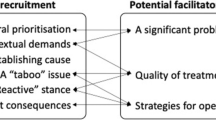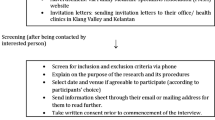Abstract
In October 2014, the US Food and Drug Administration organized a “Female Sexual Dysfunction (FSD) Patient-Focused Drug Development Public Meeting.” One year later it approved the first drug to treat female sexual desire. This qualitative content analysis used the transcript from the meeting to explore issues of FSD from the perspective of 22 female patients. Patient responses were independently analyzed by two researchers and ultimately the analysis uncovered four themes: confusion of sexuality-related terms, inherent sexual desire, a need to control sexuality, and satisfaction: pleasure versus success. Our discussion of these themes considered patients’ understanding of sexual concepts, the issues of FSD from the patients’ perspectives, solutions for sexual dissatisfaction, and the role of social construction and expectations. The expectation of a consistent and “normal” sexual experience throughout the lifespan without regard for life context was critiqued. Implications for future research were suggested based on the variation of problems reported and the efficacy of future drug trials for concerns relating to FSD.
Similar content being viewed by others
References
Allina, A. (2001). Orgasms for sale: The role of profits and politics in addressing women’s sexual satisfaction. In E. Kaschak & L. Tiefer (Eds.), A new view of women’s sexual problems (pp. 211–218). Binghamton, NY: The Hawthorn Press Inc.
American Psychiatric Association (APA). (2013). Diagnostic and statistical manual of mental disorders, DSM-5 (5th ed.). Washington, DC: American Psychiatric Association (APA).
Bancroft, J., Loftus, J., & Long, J. S. (2003). Distress about sex: A national survey of women in heterosexual relationships. Archives of Sexual Behavior, 32(3), 193–208. Retrieved from http://www.kinseyinstitute.org/publications/PDF/JohnDistressArticle.pdf
Becker, G., & Nachtigall, R. D. (1992). Eager for medicalisation: The social production of infertility as a disease. Sociology of Health and Illness, 14(4), 456–471. doi:10.1111/1467-9566.ep10493093.
Cacchioni, T. (2015). Big pharma, women, and the labour of love. Toronto: University of Toronto Press.
Cacchioni, T., & Tiefer, L. (2012). Why medicalization? Introduction to the special issue on the medicalization of sex. Journal of Sex Research, 49(4), 307–310. doi:10.1080/00224499.2012.690112.
Center for Drug Evaluation and Research (CDER) & U.S. Food and Drug Administration (FDA). (2015, June). The voice of the patient: Female sexual dysfunction. Retrieved from http://www.fda.gov/downloads/Drugs/NewsEvents/UCM453718.pdf
Chańska, W., & Grunt-Mejer, K. (2016). The unethical use of ethical rhetoric: The case of flibanserin and pharmacologisation of female sexual desire. Journal of Medical Ethics, 42(11), 701–704. doi:10.1136/medethics-2016-103473.
Conrad, P. (2007). The medicalization of society: On the transformation of human conditions into treatable disorders. Baltimore, MD: Johns Hopkins University Press.
Conrad, P., & Leiter, V. (2004). Medicalization, markets and consumers. Journal of Health and Social Behavior, 45 (Extra Issue), 158–176. Retrieved from http://www.jstor.org/stable/3653830
Food and Drug Administration (FDA). (2014a, September 26). Patient-focused drug development public meeting and scientific workshop on female sexual dysfunction (Document citation 79 FR 57942; Docket No. FDA-2014-N-1413). Washington, DC: U.S. Government Printing Office. Retrieved from https://federalregister.gov/a/2014-22983
Food and Drug Administration (FDA). (2014b, October 27). Female sexual dysfunction, patient-focused drug development, public meeting. Silver Spring, MD: Capital Reporting Company. Retrieved from http://www.fda.gov/downloads/Drugs/NewsEvents/UCM423113.pdf
Food and Drug Administration (FDA). (2015a, August 18). FDA approves first treatment for sexual desire disorder: Addyi approved to treat premenopausal women. Press Announcements. Retrieved from http://www.fda.gov/NewsEvents/Newsroom/PressAnnouncements/ucm458734.htm
Food and Drug Administration (FDA). (2015b, July 2). Patient-focused drug development: Disease area meetings planned for fiscal years 2013–2017. Retrieved from https://www.gpo.gov/fdsys/pkg/FR-2015-07-02/pdf/2015-16359.pdf
Gilbert, E., Ussher, J. M., & Perz, J. (2013). Embodying sexual subjectivity after cancer: A qualitative study of people with cancer and intimate partners. Psychology and Health, 28(6), 603–619. doi:10.1080/08870446.2012.737466.
Gupta, K. (2011). “Screw health”: Representations of sex as a health-promoting activity in medical and popular literature. Journal of Medical Humanities, 32(2), 127–140. doi:10.1007/s10912-010-9129-x.
Katz, S., & Marshall, B. (2003). New sex for old: Lifestyle, consumerism, and the ethics of aging well. Journal of Aging Studies, 17(1), 3–16. doi:10.1016/S0890-4065(02)00086-5.
Kim, E. (2010). How much sex is healthy? The pleasures of asexuality. In J. M. Metzl & A. Kirkland (Eds.), Against health: How health became the new morality (pp. 157–169). New York, NY: New York University Press.
Laumann, E. O., Paik, A., & Rosen, R. C. (1999). Sexual dysfunction in the United States: Prevalence and predictors. Journal of the American Medical Association, 281(6), 537–545. doi:10.1001/jama.281.6.537.
Loe, M. (2004). The rise of Viagra: How the little blue pill changed sex in America. New York, NY: New York University Press.
Marshall, B. L. (2012). Medicalization and the refashioning of age-related limits on sexuality. Journal of Sex Research, 49(4), 337–343. doi:10.1080/00224499.2011.644597.
Masters, W. H., & Johnson, V. (1966). Human sexual response. Boston, MA: Little Brown.
Metz, M. E., & McCarthy, B. W. (2007). The “good-enough sex” model for couple sexual satisfaction. Sexual and Relationship Therapy, 22(3), 351–362. doi:10.1080/14681990601013492.
Peterson, L. (2014). FDA public workshop on female sexual dysfunction, White Oak, MD, October 27–28, 2014. Trends in Medicine, 1–19. Retrieved from www.trends-in-medicine.com
Pillai-Friedman, S., & Ashline, J. L. (2014). Women, breast cancer survivorship, sexual losses, and disenfranchised grief—A treatment model for clinicians. Sexual and Relationship Therapy, 29(4), 436–453. doi:10.1080/14681994.2014.934340.
Plante, R. F. (2006). Sexualities in context: A social perspective. Boulder, CO: Westview Press.
Potts, A. (2008). The female sexual dysfunction debate: Different ‘problems’, new drugs—More pressures? In P. Moss & K. Teghtsoonian (Eds.), Contesting illness: Processes and practices (pp. 259–280). Toronto: University of Toronto Press Inc.
Riessman, C. K. (1983). Women and medicalization: A new perspective. Social Policy, 14(1), 3–18.
Segal, J. Z. (2012). The sexualization of the medical. Journal of Sex Research, 49(4), 369–378. doi:10.1080/00224499.2011.653608.
Segal, J. Z. (2015). The rhetoric of female sexual dysfunction: Faux feminism and the FDA. Canadian Medical Association Journal, 187(12), 915–916. doi:10.1503/cmaj.150363.
ter Kuile, M. M., Both, S., & van Lankveld, J. J. D. M. (2010). Cognitive behavioral therapy for sexual dysfunctions in women. Psychiatric Clinics of North America, 33(3), 595–610. doi:10.1016/j.psc.2010.04.010.
Tiefer, L., Laan, E., & Basson, R. (2015). Missed opportunities in the patient-focused drug development public meeting and scientific workshop on female sexual dysfunction held at the FDA, October 2014. Journal of Sex Research, 52(6), 601–603. doi:10.1080/00224499.2014.1003362.
Wood, J. M., Koch, P. B., & Mansfield, P. K. (2006). Women’s sexual desire: A feminist critique. Journal of Sex Research, 43(3), 236–244. doi:10.1080/00224490609552322.
Acknowledgements
We would like to thank Leonore Tiefer, Cynthia Graham, and Virginia Braun for providing valuable feedback to early drafts of this work.
Funding
This study did not receive any funding.
Author information
Authors and Affiliations
Corresponding author
Ethics declarations
Ethical approval
All procedures performed in studies involving human participants were in accordance with the ethical standards of the institutional and/or national research committee and with the 1964 Helsinki declaration and its later amendments or comparable ethical standards.
Additional information
Jiná Ashline and Kimberly McKay have contributed equally to this work.
Rights and permissions
About this article
Cite this article
Ashline, J., McKay, K. Content Analysis of Patient Voices at the FDA’s “Female Sexual Dysfunction Patient-Focused Drug Development Public Meeting”. Sexuality & Culture 21, 569–592 (2017). https://doi.org/10.1007/s12119-016-9405-7
Published:
Issue Date:
DOI: https://doi.org/10.1007/s12119-016-9405-7




